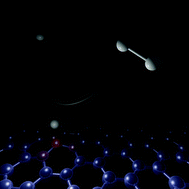Full quantum dynamical investigation of the Eley–Rideal reaction forming H2 on a movable graphitic substrate at T = 0 K
Abstract
The dynamics of the Eley–Rideal abstraction reaction of hydrogen atoms on a movable graphitic surface is investigated for the first time in a numerically exact fully quantum setting. A system-bath strategy was applied where the two recombining H atoms and a substrate C atom form a relevant subsystem, while the rest of the lattice takes the form of an independent oscillator bath. High-dimensional wavepacket simulations were performed in the collision energy range 0.2–1.0 eV with the help of the multi-layer multi-configuration time-dependent Hartree method, focusing on the collinear reaction on a zero-temperature surface. Results show that the dynamics is close to a sudden limit in which the reaction is much faster than the substrate motion. Unpuckering of the surface is fast (some tens of fs) but starts only after the formation of H2 is completed, thereby determining a considerable substrate heating (∼0.8 eV per reactive event). Energy partitioning in the product molecule favors translational over vibrational energy, and H2 molecules are vibrationally hot (∼1.5 eV) though to a lesser extent than previously predicted.



 Please wait while we load your content...
Please wait while we load your content...